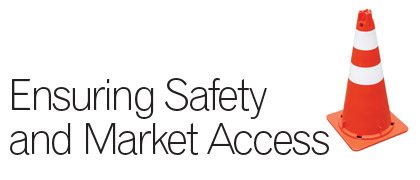Much progress has been made recently on the development and adoption of international phytosanitary standards, while at the same time staying on top of food safety practices right here on U.S. soil—which will lead to safer food and better market access.
Improving and streamlining phytosanitary measures to ensure market access around the world is one of the most important issues in the seed industry today, especially for the flower and vegetable sector.
According to the American Seed Trade Association, “international standards create a predictable trade environment as well as a level playing field for how different countries regulate seed shipments, and provide a basis for challenging regulatory actions when they are not justified according to these standards.”
The seed industry has been encouraging international organizations such as the North American Plant Protection Organization and the International Plant Protection Commission to develop and adopt international phytosanitary standards for many years. Fortunately, progress was finally made last spring. On March 19, 2013, the first international standard for seed movement was finally approved and adopted by NAPPO.
Referred to as Regional Standard for Phytosanitary Measures 36 and titled Guidelines for the Movement of Seed, this standard lays out criteria for the movement of seed into, from, and among NAPPO member countries and for procedures to facilitate re-exportation of seed, says Ric Dunkle, senior director for Seed Health and Trade for ASTA. The NAPPO member countries are Canada, Mexico and the United States.
“Work on this standard began in 2009 by a NAPPO seed panel that consisted of members from the national plant protection offices and ex officio industry representatives from the three countries. I served on this panel as the U.S. industry representative,” says Dunkle.
This standard outlines the general phytosanitary requirements for a National Plant Protection Office of the country of origin to follow for moving seed internationally, including seed for re-export, into, from and among NAPPO member countries.
“International standards create a predictable trade environment as well as a level playing field for how different countries regulate seed shipments”
|
These general requirements include how to properly document country of origin and guidelines for including additional official phytosanitary information on a certificate that will assist NPPOs in the issuance of phytosanitary certificates for re-export. In addition, these general requirements address pest risk assessment and pest risk mitigation by including criteria for determining if seed is a pathway for the potential introduction of regulated pests, and if plant pathogens are known to be seed-borne or seed transmitted.
Seed certification, testing and diagnostic protocols for particular seed pests are recommended under the standard. It also provides guidelines for obscured and restricted/prohibited seed. Technical appendices and an annex are included to identify specific recommended protocols for seed pests, as well as phytosanitary treatment options for specific seed pests.
“At present, the annex and appendices include information only for a few pests of concern to the NAPPO region. A NAPPO expert working group will be established to develop information on additional pests of concern,” says Dunkle.
Since the standard was adopted, Dunkle says it has already had a major impact. Mexico has already made a number of improvements to its phytosanitary requirements for U.S.-origin seed based on this standard plus outcomes from a joint ASTA-Mexican Seed Trade Association cross-border workshop held in Nogales, Mexico, in October, 2012.
Progress has also been made within the International Plant Protection Commission, which recently made the decision to develop a phytosanitary international standard (ISPM) for seed movement. According to Dunkle, an expert working group has been formed and in July, 2013, it began work on drafting this new standard.
Last October, an ad hoc seed industry working group was formed through the International Seed Federation to draft a series of white papers on issues proposed by the industry to be included in the new seed standard. This ad hoc working group consisted of representatives from ASTA, the International Seed Federation and the Seed Association of the Americas and a number of other national seed associations and worked to develop consensus positions on all the issues proposed for inclusion in the standard.
“A total of 13 documents were developed and forwarded to the [IPPC expert working group] several weeks prior to the meeting,” says Dunkle, who was part of the group. “The [expert working group] produced a first draft which is expected to go out for country consultation sometime in 2014. The IPPC Standards Committee must first review this draft before it goes out for country consultation. The goal has been set for the IPPC to adopt this standard at its annual meeting in Rome in 2016.”
According to Dunkle, the new NAPPO standard will be extremely useful to the expert working group in the development of the global standard. Now that the process has begun, it will take at least three years to develop and to get the standard adopted by the IPPC. Once adopted, the IPPC member countries will be encouraged to base their phytosanitary import requirements and measures on this standard, which will make international seed trade much smoother and more predictable.
Food Safety Concerns
Food safety is another important aspect of proper phytosanitary measures, and one that must be dealt with at a local and domestic level. The 2006 outbreak of E. coli in the United States, associated with spinach production in California, has drawn closer scrutiny to seed as a possible source of infection. Although never proven scientifically, seed remains a concern for many as a possible source for human pathogens such as E. coli, salmonella and others.
The highest risk for the seed industry is seed that is used for the production of sprouts. ASTA maintains a capability to respond rapidly to outbreaks of human pathogens associated with vegetables which could potentially impact the vegetable seed industry through its Food Safety Pathogen Working Group. ASTA recently supplied comments to the Food and Drug Administration on their proposed rules for produce safety under the Food Safety Modernization Act.
ASTA’s comments focused on the agency’s proposed regulations that would affect seeds used for sprouting. According to its comments, ASTA strongly supports a requirement for sprouters to only use seeds that are expressly intended for sprouting. Unfortunately, some sprouters currently use seed that was not intended for that purpose.
“The seed industry cannot control diversion or unintended use of seeds after the seeds leave the producer’s facility,” says the ASTA’s report. “We hope that FDA’s produce safety regulation can help prevent this diversion problem from occurring in the future by requiring sprouters to verify that the seed they use was intended for sprouting.
“It will not improve food safety for FDA’s produce safety regulation to impose requirements on facilities that produce seed for agronomic/planting purposes. That is, FDA’s regulation should only affect facilities that produce seed expressly intended for sprouting. As noted in previous comments … seed used in fields and greenhouses for the production of fresh produce does not contribute to pathogen outbreaks. Therefore, we support FDA’s proposed limitation to only regulate seeds under the produce safety rule if they are produced with the express intent to use the seeds for sprouting. We urge FDA to clearly narrow the scope of regulation for seed to only those seeds that are produced with the express intent to use for sprouting,” continues the report.
ASTA is also preparing comments to the FDA for their proposed rule on preventative controls for feed which are due on Feb. 26, 2014. FDA is under court order to publish Final Rules for all of the regulations under FSMA by June 30, 2015.
By continuing to stay on top of safety and phytosanitary measures, the U.S. seed industry is ensuring market access and a predictable trade environment for the years to come.
Julie McNabb













